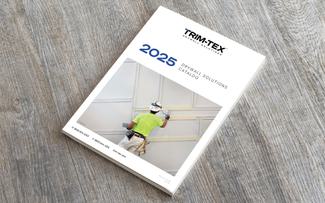Long soffit runs show every flaw in your corner bead installation — and nobody wants to remove corner bead and start over.
Getting them right means choosing the right material and installing it properly. When you do so, vinyl corner bead gives you straighter lines, better impact resistance and a cleaner finish than metal bead.
Understanding Soffits and Corner Bead
A soffit is the enclosed space where your ceiling drops down or your wall meets the roof overhang. Long soffit runs — anything over 8 feet — are common in commercial hallways, exterior overhangs and tray ceilings. These long spans need extra attention to stay straight and look clean.
Corner bead protects and finishes the exposed drywall edges on your soffits, just like it does on window returns. Think of it as armor for your corners — it takes the hits, so your drywall doesn't have to. On long soffit runs, corner bead does more than just protect. It creates those sharp, clean lines that make the whole job look professional.
Why does length matter? The longer your soffit runs, the more likely you'll see waves, dips and corners that aren't quite right. Metal bead can rust, dent and show wavy lines over long spans. That's why professionals choose vinyl corner bead for long runs — it remains straight, handles movement well and won't rust or dent like metal.
Required Materials and Tools
Here's your complete list for professional soffit corner bead installation:
- Corner Bead and Adhesives: For most soffit runs, you'll need a standard vinyl corner bead. Switch to bullnose corner bead for outside corners with a rounded edge or paper-covered corner bead for a faster finish that requires less mud. Don't forget to spray adhesive to help your compound stick better.
- Fasteners and Installation Tools: Keep your stapler loaded with ½-inch stainless steel staples.
Measuring and Alignment: Long soffits require straight lines, so you'll need a laser level on a tripod, plus 4-foot and 6-foot bubble levels for checking sections. A digital angle finder helps you catch corners that aren't square. Keep two 25-feet measuring tapes handy for long runs. (Don’t have a laser level? You can snap a chalk line instead!)
- Cutting and Finishing: Pack your heavy-duty snips for clean vinyl cuts, utility knife with carbide blades and both 6-inch and 12-inch taping knives. Keep medium-grit sanding sponges and clean rags ready for prep work.
Surface Preparation and Measurement
Good corner bead installation starts before the vinyl hits the wall. Here's how to set yourself up for success on long soffit runs:
- Clean all surfaces with a dry brush and vacuum — debris under your vinyl will show.
- Check that drywall is installed on 16-inch centers maximum.
- Look for fasteners that sit slightly recessed but haven't broken the paper.
- Fix damaged drywall edges with setting compound and let it cure.
- Sand down any high spots or paper burrs until they're flush.
- Mark all your framing locations with a chalk line — you'll need these for fastening.
- Check the surface temperature of the drywall (needs to be between 50°F to 100°F).
- Clean spots where adhesive will touch with denatured alcohol.
- Check that the humidity in the room where you're installing the corner bead is within the range recommended by the manufacturer.
For accurate measurements:
- Measure complete soffit runs from inside corners.
- Mark reference points every 48 inches to keep things straight.
- Plan for expansion gaps at corner transitions.
- Double-check all dimensions against your building plans.
- Mark where the ceiling meets the wall clearly.
- Use your digital angle finder to check all corners for squares.
- Note any corners that aren't 90 degrees — you'll need to adjust for these.
- Calculate how much material you need plus waste.
- Plan your joints where they'll be least visible.
Write down all your measurements — even slight variations between soffits can cause problems if you try to cut everything the same.

